
Yes! Whether you're living large in a mansion or cosying up in a cottage, do bear in mind that the solar panels have an entry-level price tag of around £5,000.
Have a look at this handy table below - it shows you the possible energy output and what you might be paying out for each system size
| System Size | Annual Energy Output | Annual Savings | Cost Estimate |
|---|---|---|---|
| 3 kW | 2,700 kWh | £160 | £5,000 – £6,000 |
| 4 kW | 3,600 kWh | £270 | £6,000 – £8,500 |
| 5 kW | 4,320 kWh | £320 | £8,500 – £9,500 |
| 6 kW | 5,400 kWh | £430 | £9,000 – £11,500 |
Please note that these are approximate values and the actual payback period can vary depending on factors like solar panel type and quality, installation complexity, extra equipment (e.g., solar inverters and solar batteries), and property location. Also, the savings can increase if electricity prices rise in the future.
It’s also worth noting that the UK had more than 1.3 million homes with solar panel installations as of 2023, and the solar power capacity in the UK is expected to grow by more than 5% annually. This indicates a positive trend towards renewable energy sources in the UK.
So the UK public obviously think that solar panels are worth it in 2024.
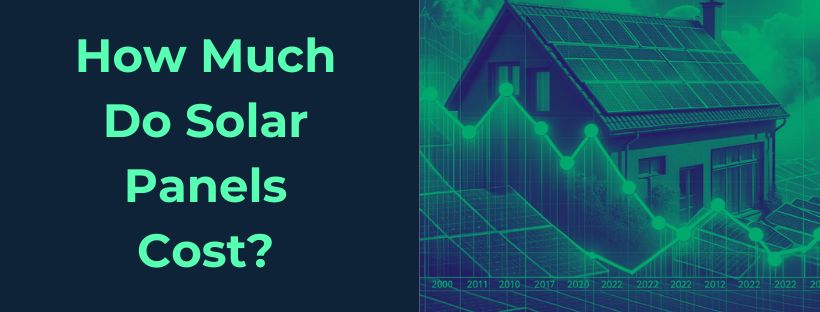
Let's get straight to the point - a 350-watt solar panel (the regular kind) will set you back about £150-£300 each. It's worth noting that once labour, installation, materials and other business costs involved to have it on your roof... works out around £786 per panel.
So, for your run-of-the-mill three-bedroom palace, you're looking at 10 of these – you do the maths - it's a cool £7,860 overall.
| Property Size | Annual Usage | Number of Solar Panels | Average Cost | Annual Savings | Total Savings over 25 Years |
|---|---|---|---|---|---|
| 1 bedroom house | 1,800 kWh | 3 | £4,700 | £161 | £4,025 |
| 2 bedroom house | 2,700 kWh | 6 | £5,500 | £322 | £8,050 |
| 3 bedroom house | 2,700 kWh | 10 | £7,860 | £537 | £13,425 |
| 4 bedroom house | 4,100 kWh | 14 | £11,000 | £752 | £18,800 |
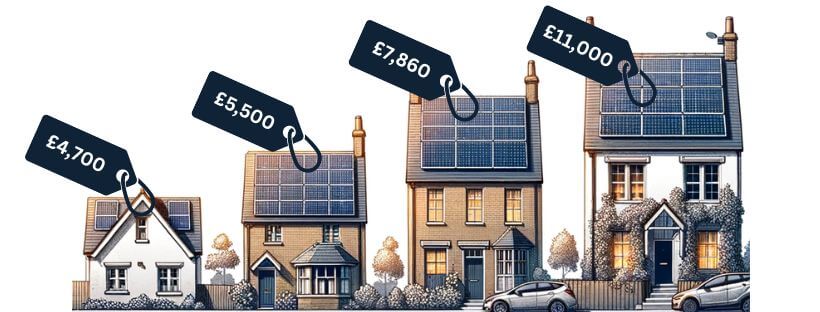
Note: These are average values and actual numbers can vary based on many factors such as location, energy consumption, type of solar panels, etc. Also, the annual savings and total savings over 25 years are based on the current energy prices and can change over time.
Look, no one said going solar would be a cheap date. The Eco Experts think you'll be looking at around £7,860 to kit out your typical three-bed, four-occupant semi-detached with solar panels.
The actual figure can bounce around depending on factors like the size of your house and the energy you need to generate. But, remember, we invest in solar panels because they're long-term savers, not just a pretty face. So, that upfront cost might actually be a cheeky wink to future savings.
Plus, here's a bit of sunshine for your day: solar panel costs have nosedived by a whopping 88% since 2010! Seems like solar is gradually becoming more of a crowd pleaser, eh? Definitely worth your consideration.
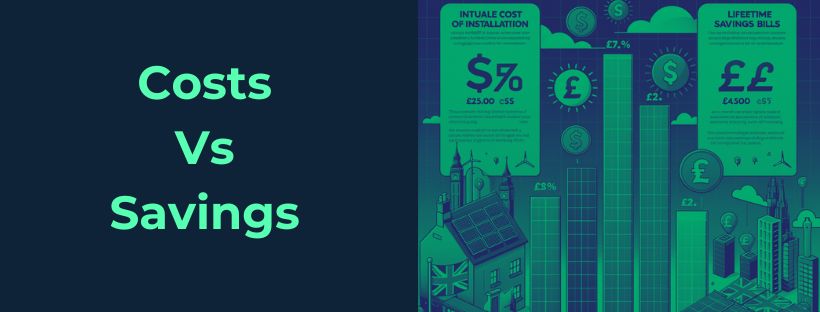
No one can argue that we haven't seen an uptick in the cost of solar panels from 2022 to 2023, that's undeniable. But hold onto your hats, folks, 'cos the electric tariffs in the UK have been skyrocketing at an even swifter pace! Let's take a cheeky peek at the numbers:
| Year | 2021/2022 | 2022/2023 | Change (%) |
|---|---|---|---|
| annual 3,600 kWh electricity bill | £833 | £1,288 | 55% increase |
| 0-4 kW capacity solar system | £1,876 per kW | £2,365 per kW | 26% increase |
Now, here's a cheeky little factoid: the cost of solar panels has shot up a whopping 26% since the wee days of 2022. On the flip side, the cash you'll be saving on the old electricity bills has skyrocketed by 55% within the same period. So while you might wince at the upfront price in 2024, it could still make a bit of a fiscal sense to have solar panels installed.
Solar panel prices in the UK have gone through a proper tumble over the last ten years.
Advanced tech, better production rates, bulk buying, and a friendly nod from government policies have all chipped in.
What's the upshot?
Well, it's a brighter day for homeowners – solar energy's now more affordable and within their reach.
| Year | Estimated Solar PV Module Cost (£/W) | Estimated Installed Price of Residential Solar Panel Systems (£/W) |
|---|---|---|
| 2010 | 1.38 | 4.73 |
| 2011 | 1.08 | 4.43 |
| 2012 | 0.79 | 4.13 |
| 2013 | 0.57 | 3.82 |
| 2014 | 0.47 | 3.52 |
| 2015 | 0.43 | 3.21 |
| 2016 | 0.40 | 2.90 |
| 2017 | 0.38 | 2.60 |
| 2018 | 0.34 | 2.29 |
| 2019 | 0.31 | 1.99 |
| 2020 | 0.27 | 1.68 |
| 2021 | 0.23 | 1.38 |
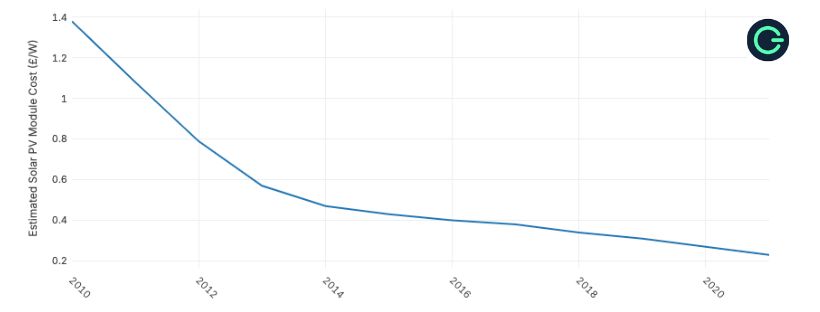
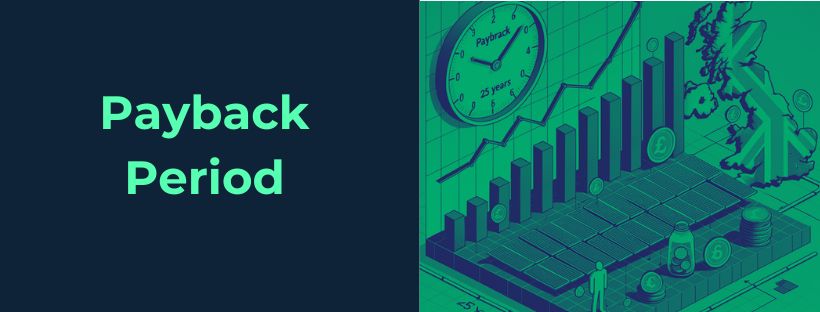
So, in plain English, you're replacing your hefty electricity bill with sleek, shiny, new solar panels, right? And you're crossing your fingers hoping it's worth it?
Well, statistics say you'll likely start seeing a return on your investment around the 11-year mark.
This factors in your smaller energy bills and the extra cash you get from flogging your surplus energy back to the grid.
| Region | 1st Year Savings (No Battery) | 1st Year Savings (With Battery) | Payback Period (No Battery) | Payback Period (With Battery) | Average Annual Production (kWh) | Average Consumption (%) |
|---|---|---|---|---|---|---|
| Surrey | £940 | £1,400 | 6 years | 7 years | 4,000 | 30% |
| Cornwall | £950 | £1,420 | 6 years | 7 years | 4,100 | 32% |
| Kent | £980 | £1,460 | 6 years | 7 years | 4,200 | 31% |
| Manchester | £960 | £1,425 | 5.8 years | 6.3 years | 3,900 | 29% |
| Sheffield | £930 | £1,390 | 6 years | 7 years | 3,800 | 28% |
| Bedfordshire | £940 | £1,400 | 5.5 years | 6.2 years | 4,000 | 30% |
| Essex | £935 | £1,390 | 6 years | 7 years | 3,950 | 29% |
| Norfolk | £950 | £1,420 | 6 years | 7 years | 4,100 | 32% |
| Norwich | £880 | £1,320 | 5.8 years | 6 years | 3,700 | 27% |
| Oxfordshire | £890 | £1,330 | 5.8 years | 6 years | 3,800 | 28% |
| Suffolk | £940 | £1,400 | 5.2 years | 5.5 years | 4,000 | 30% |
| Southampton | £980 | £1,440 | 5.4 years | 5.9 years | 4,200 | 31% |
| Bristol | £970 | £1,420 | 6 years | 6.8 years | 4,100 | 32% |
| Newcastle | £1,000 | £1,600 | 6 years | 6.5 years | 4,300 | 33% |
| Ipswich | £960 | £1,400 | 5.2 years | 6.2 years | 3,900 | 29% |
| London | £950 | £1,385 | 6.2 years | 7 years | 4,000 | 30% |
Sources: [1]
Note: The average annual production and consumption percentages are based on a hypothetical 4kW solar panel system. These figures are illustrative and may vary based on actual conditions and system performance.
Could the old British weather throw a spanner in the works when it comes to solar energy returns?
Sure, it's not always sunny in the UK, but lo and behold, you can still slice your energy bills in half!
Yep, with the best solar panels, you could see your electricity bills tumble by about 50%.
Now, don't go planning your retirement just yet, because the average UK household has to wait for about 15.1 years to break even with solar panels.
"Wait a minute," I hear you say. "What about my massive estate or my cosy little flat? Could property size and energy consumption affect this?" Well, you'd be right on the money. Your break-even point will change depending on these factors, as well where in the UK you're nested.
| Region | Sunlight Exposure |
|---|---|
| South East England | High |
| South West England | High |
| East of England | High |
| London | High |
| West Midlands | Medium |
| East Midlands | Medium |
| Yorkshire and Humber | Medium |
| North West England | Medium |
| North East England | Low |
| Scotland | Low |
| Wales | Low |
| Northern Ireland | Low |
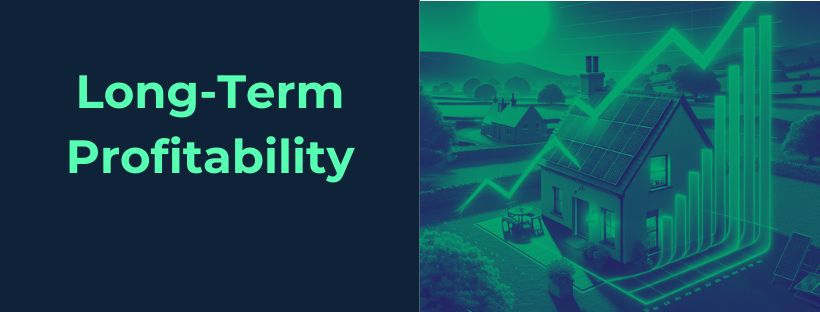
Installation Costs and Energy Generation
So, what's the installation costs if you fancy getting a 3.5 kilowatt-peak solar panel system? Well, brace yourself for a cool £7,000 - yikes![1].
However, if it's any consolation, the love for solar power is blossoming in the UK.
In 2021, the UK flexed its green muscles by pumping out 730MW from newly minted solar power systems.
Now, that's a whopping 36% leap from the previous year's 538MW[2].
Solar Panel Installation Costs in the UK
| Year | Cost per kW for 0-4kW systems |
|---|---|
| 2023 | £2,570 |
| 2022 | £2,040 |
| 2021 | £1,880 |
Solar Energy Generation Capacity in the UK
| Year | Total Solar Capacity | New Installations |
|---|---|---|
| 2023 | 15 GW | 0.952 GW |
| 2022 | 14.048 GW | 0.730 GW |
| 2021 | 13.318 GW | 0.538 GW |
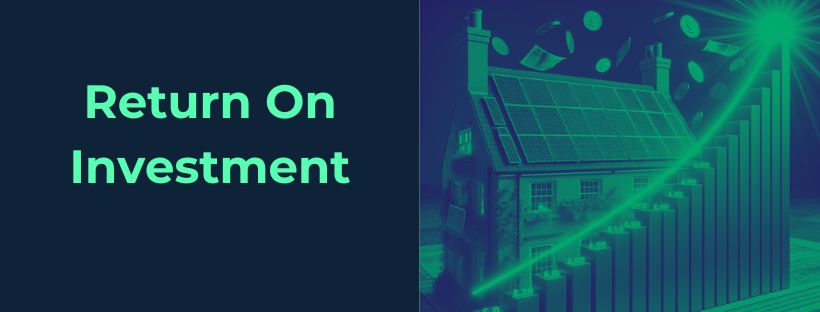
Calculating the return on investment (ROI) for solar panels is a bit of a numbers dance that involves juggling your initial set-up costs, potential energy savings, and any sweet little government incentives you might be entitled to.
Here's how you can tot up these figures:
Divide the total cost of your solar panel system by the yearly benefits you'll bag. What benefits, you ask? Well, think along the lines of the money you'll save on energy bills or the cash you'll earn from exporting surplus energy [1].
Simple Payback Period (SPP) = Annual Financial Benefits / Total Initial Investment
So, what's the SPP all about? In layman's terms, it's the time it'll take for your shiny solar power set-up to claw back its initial cost via energy savings and other money-wise perks.
Bear in mind, though, this is just a broad brushstroke. Your actual payback could be different, being influenced by a variety of factors. That's why it's always a smart move to do a thorough cost-benefit analysis.
Put simply, this method is all about the value of money over time. It considers both cash coming in and going out tied to your solar panel system, then deducts the initial cost you dished out [1].
Calculation:
To compute NPV, follow these steps:
Interpretation:
This is the discount rate that makes the NPV of all cash flows (both costs and benefits) from a solar panel system equal to zero [2].
Definition:
Calculation:
NPV=∑(1+IRR)tCashFlowt=0
where:
Interpretation:
UK Context:
Remember, IRR provides insights into the long-term financial viability of solar projects. It’s a key metric for decision-making and understanding the economic impact of going solar. 🌟🔍
Note: These calculations can be complex and might require professional financial advice. They also depend on various factors such as geographical location, size and efficiency of the solar panel system, local electricity rates, and available government incentives. Therefore, the actual ROI may vary. It’s always recommended to conduct a detailed cost-benefit analysis to work out if solar panels are worth it for you before investing.
Right, let's talk about how long these shiny solar panels last. Apparently, they've got a decent innings of about 25 to 30 years.
Now, you might be thinking, "What happens then? Do they just give up?"
Well, not exactly... They're worth more than that.
According to the National Renewable Energy Laboratory (NREL), these solar powerhouses only lose about 0.5% of their mojo each year. So, by their 30th birthday party (there's no cake, I checked), they'll still be pumping out 80 to 85% of the energy they were producing when they were fresh-faced and new.
| System Age | Degradation Rate |
|---|---|
| 1 year | 0.5% |
| 10 years | 5% |
| 20 years | 10% |
| 30 years | 15% |
Solar panels in the UK typically have a typical lifespan of 25 to 30 years[1]. High-quality panels degrade at an average rate of around 0.4% to 0.5% per year[2]. By the 30th year, a solar panel will only be producing 80% to 85% of what it generated in its first year of operation[1]. Keep in mind that these figures can vary based on factors such as panel type, quality, and maintenance. 🌞🔌
These are just some of the ways you can work with the numbers to figure out if the best solar panels are worth it for your home.
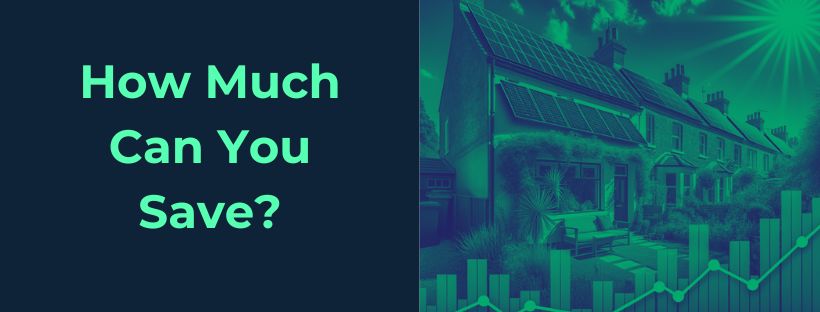
Alright, in the spirit of keeping it simple, you want to know how much you'll save with solar panels, right?
There's a few factors in this equation: how big your system is, how much electricity your home chews through, and where you live.
Typically, a residential solar panel pumps out 250-400 watts per hour.
What does that mean? Well, it's time to say ta-ra to those massive electricity bills, my friend!
Here are some figures to give you an idea of the potential savings:
| Energy Supplier | Tariff Type | Rate (p/kWh) | Includes Battery Storage |
|---|---|---|---|
| Octopus Energy | Flexible | 24p | Yes |
| Fixed | 15p | Yes | |
| ScottishPower | Flexible | 15p | Yes |
| Fixed | 12p | No | |
| British Gas | Flexible | 6.4p | No |
| OVO Energy | Fixed | 4p | Yes |
| Shell Energy | Flexible | 3.5p | Yes |
| E.ON | Fixed | 3p | No |
| EDF Energy | Flexible | 3p | Yes |
| Utility Warehouse | Flexible | 2p | - |
Please note that these rates are subject to change, and it’s advisable to verify exact rates and terms with your chosen supplier before committing. The SEG allows private energy generators to receive payment for exporting excess electricity into the national grid, replacing the previous Feed In Tariff (FIT) scheme. If you have any solar panels, these tariffs can help you maximise your earnings from exported solar energy! 🌞🔌
Punchy facts across the board, including perusals from Solar Energy UK and, even, Admiral (yeah, that Admiral!), propose that these sunshine lovers could amp up your home's net worth by anywhere from a nippy little 0.9% to a whopping 25%.
Remember though, it's not all sun and rainbows! Your actual windfall will hinge, partly on the costs you've swallowed, the mood swings of the housing market, and your postcode along with the kind of property you're in.
| Study | Findings |
|---|---|
| Solar Energy UK | Solar panels could increase the value of a property by 0.9% to 2% |
| EffectiveHome | Properties with solar panels in the UK experienced an average increase in sale prices of 14%. Houses in London saw the biggest increase, with a value jump of £90,000, followed by Bristol (£45,142), Edinburgh (£40,095), and Leicester (£31,577) |
| Admiral | Going solar could increase the price of a home in the UK by up to 25%. Adding solar panels to a property can generate equity similar to that of an extension or garden room. |
Note: These studies provide different perspectives on the potential increase in home value due to solar panels. It's important to consider multiple sources and consult with professionals in your area for a more accurate assessment of the impact of solar panels on home valuation.
1. Electricity Bill Savings: Solar batteries give you a break from relying on the national grid, helping you potentially save a bob or two on electricity bills. They're like a secret stash of energy - soaking up the surplus from your solar panels to use when the sun decides it's had enough for the day. You can even dodge those pesky higher costs during the grid's peak hours, cheeky!
2. Cost Reduction Opportunities: With the Smart Export Guarantee (SEG), you can make some cash from your stored electricity by sending it back to the grid. Bonus tip: Save on VAT! Until 2027, you can get your hands on a VAT reduction for solar panels and solar batteries (only when they’re fitted with a solar panel system). This can help trim that overall cost. Bottom line? Who said going green couldn’t save some green!
3. Energy Independence and Resilience: Solar batteries give you a bit of a safety net during power cuts and let you use your solar energy when it's dark, so you're not always depending on the main power grid.
4. Individual Circumstances: The worth of solar panels and their batteries can swing back and forth based on your own unique scenario. Things like where you live, how much energy you gulp down, and the rates your utility service charges all play their parts. To know how much you might benefit yourself personally, it's best to chat with some of the best solar installers, who can give you the lowdown on the potential pros and cons for your particular case.
Solar Panels can slash your electricity bills by up to 70%, potentially boost your property value by up to 25% and give you world-saving credentials by cutting carbon emissions. Plus, they work as a great buffer against ever-rising energy costs, and the government sweetens the deal with schemes like the Smart Export Guarantee (SEG).
Well, up in Scotland they might just be your cup of tea. Not only might they slash your electricity bills by up to 70% (not too shabby, eh?). On top of that, the Scottish government is chuffed to bits about them and offers various incentives to make the decision even sweeter. With more than 148,000 households already having solar panels installed. Solar Energy UK predicts that Scotland's solar capacity will more than treble by 2030.
Typical costs range between £3,000 to £8,000, depending on your roof's size and how many panels you need. Don't sweat it, though, because technology and competition have brought prices down over the years, even despite a teensy-weensy uptick in 2022/23.
Check your energy consumption and the sunniness of your rooftop. Size your system accordingly, then add up the costs (panels, installation, permits, etc.) Offset these with any grants or tax rebates, then see how much you save on electricity annually. Divide initial costs by savings to get your payback period. Remember the long game though - less fossil fuel dependence, more sustainable living, and possibly a boosted house price.
Solar Panels can reduce your electricity bills, so you're spending less on your electricity and more on your artisan gin collection. The panels can pack quite the financial punch with long-term savings, especially with incentives and the smart export gaurantee (SEG).
Solar panels have a respectable lifespan of 25 to 30 years, potentially producing electricity way past their predicted sell-by date, albeit with a dip in energy output. Their longevity could hinge on the quality, installation, external squalls or the odd pigeon attack, but rest assured these panels are pretty robust and only ask for minimal TLC. Reputable manufacturers even toss in warranties of 25 years, ensuring your panels won't go on a power production strike anytime soon.
There are several ways to earn money from solar panels, including net metering; the Smart Export Gaurantee, electricity bill savings; and government tax incentives. However, these opportunities vary greatly due to location, regulations, specific programmes, system size, energy consumption, electricity rates, and installation cost.